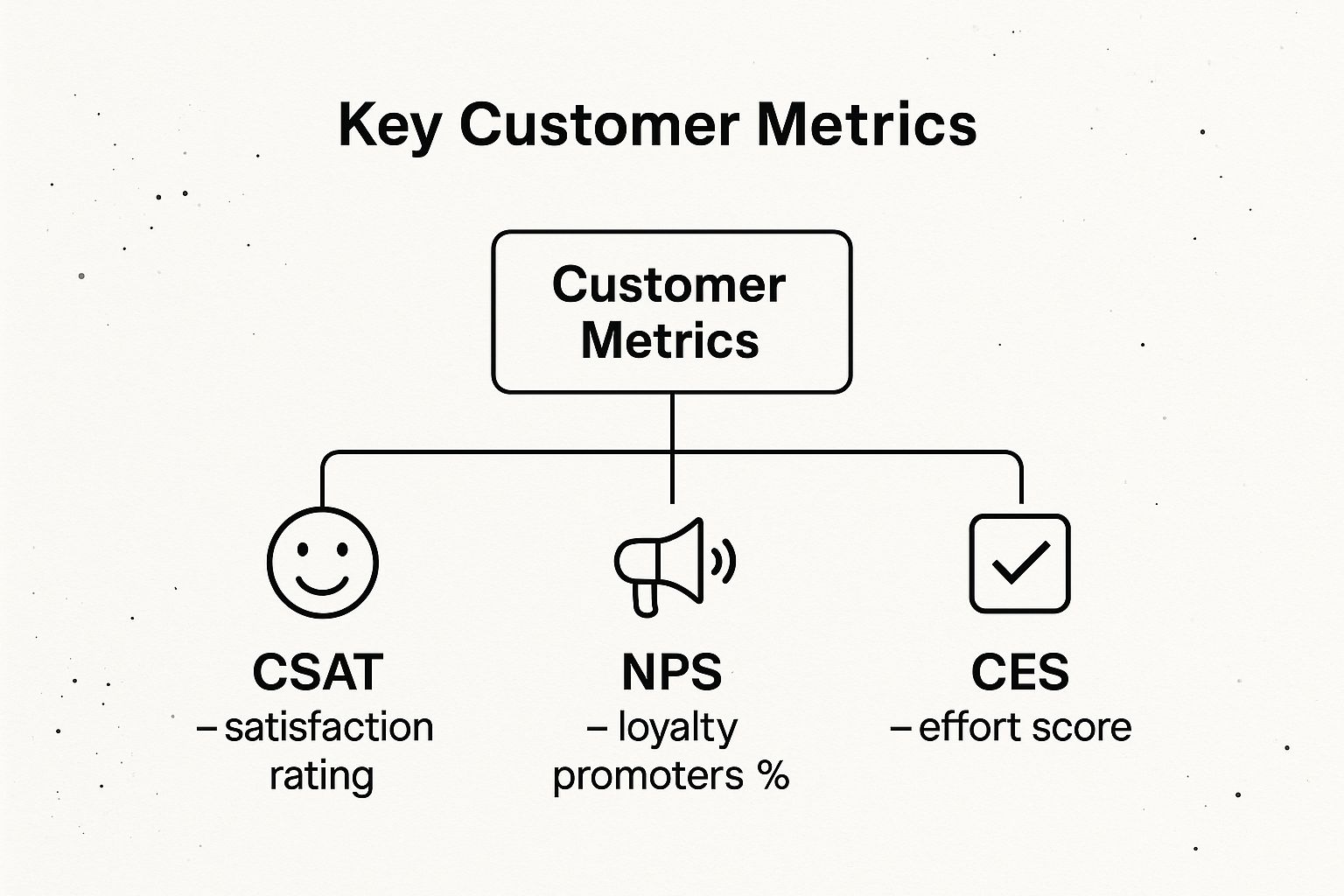Your Customer Satisfaction Metrics Are a Lie
Discover the customer satisfaction metrics that actually drive growth. This guide exposes vanity metrics and shows you how to measure what truly matters.
Posted by
Related reading
Stop Guessing Churn. Use This Simple Calculator to See How Much Money You’re Burning
Your churn isn’t a mystery. Use this simple churn cost calculator to see how much revenue you’re losing every month—and how better feedback analysis can win it back.
Your Customers Are Telling You How to Beat Your Competitors, but You're Not Listening
What is text analytics? A blunt guide for founders on turning messy customer feedback into a data-driven roadmap for growth and revenue.
You’re Building a Product Nobody Wants. Here's How to Fix It.
Master coding data for qualitative research to turn messy feedback into actionable insights and a clear product roadmap.
You think that 9/10 satisfaction score means you’re winning? It means nothing. It’s a vanity metric you slap in a pitch deck to feel good while your churn rate quietly eats your company alive. You’re not measuring satisfaction; you’re measuring your customers’ politeness right before they ghost you.
I nearly drove my first company into a ditch chasing "happy customers." We had a stellar CSAT score. We also had a user base that was churning like butter. We were so high on the smell of our own survey data that we missed the most important truth: satisfaction is a feeling, but retention is a behavior.
Ignore your customers, and you’ll be lucky to survive the quarter.
The Politeness Trap
Here’s a hard truth nobody admits: most of your customers are too polite to tell you your baby is ugly. They’ll click "5 stars" just to close the damn pop-up and get back to their day. That’s not loyalty. That’s apathy. You’re mistaking a polite nod for a standing ovation.
The problem with most customer satisfaction metrics is they measure a fleeting emotion after a single transaction. This guide isn't about collecting more smiles. It's about finding the metrics that actually correlate to cash in the bank. Instead of just chasing high scores, a proactive approach means understanding and implementing strategies for how to improve customer experience.
"A satisfied customer isn't one who says they're happy. It's one whose behavior proves it. They stay, they pay, and they drag their friends along."
This isn't just a founder-in-the-trenches rant. Qualtrics found that while self-reported satisfaction scores are stable, actual consumer trust and intent to repurchase are tanking. The market is screaming that a happy customer isn't necessarily a loyal one. You need to use customer feedback insights to separate the signal from the polite noise.

Takeaway: Stop chasing smiley faces and start tracking the behaviors that actually build a business.
The Only Three Metrics That Aren't Bullshit
Stop drowning in the alphabet soup of metrics. If you’re tracking more than a handful of customer satisfaction metrics, you're just making noise to feel productive. Most guides will give you a dictionary definition. We’re going to treat these like a founder staring down a term sheet—looking for the catch.
CSAT: The Post-Transaction High-Five
Customer Satisfaction (CSAT) is the junk food of metrics. Fast, easy, feels good for a second. It asks, "How satisfied were you?" right after a support ticket or a purchase.
Use it to spot fires. A support agent getting 1-star ratings is a problem. A new checkout flow getting 5-stars is a win. But that’s it. It only measures a single moment. Mistaking a good CSAT score for loyalty is like thinking a good first date guarantees a wedding. It just means you didn't screw up that one interaction.

Takeaway: CSAT tells you how you did just now, not how you’re doing overall.
NPS: The "Would You Vouch for Me?" Test
Net Promoter Score (NPS) has teeth because it asks a question with stakes: "How likely are you to recommend us?" Recommending a product is an act of social currency. Nobody wants to look like an idiot by recommending junk to a friend.
This single question cuts through the polite bullshit. Promoters are your unpaid sales force. Detractors are brand terrorists actively working against you. NPS is a lagging indicator, meaning it tells you about the damage you've already done. But it’s the closest thing you have to a crystal ball for long-term growth. If you care about staying in business, you better learn how to measure customer loyalty.
Your NPS score isn't a report card. It's a diagnosis. A low score tells you the patient is sick, and the verbatim comments tell you exactly where the cancer is.
Takeaway: NPS measures brand allegiance, not transactional happiness.
CES: The "Stop Wasting My Time" Metric
Customer Effort Score (CES) is the most underrated metric of the three. It asks, "How easy was it to handle your request?" High effort is the silent killer of loyalty. Your customers aren't excited to call you; they’re calling because something is broken.
If you make solving that problem a soul-crushing odyssey of transfers and repeated questions, they will leave you. They will forgive a bug. They will never forgive you for disrespecting their time. CES points you directly to the friction in your machine—the sludge in your gears—so you can clean it out.
Takeaway: CES tells you how much of a pain in the ass you are to do business with.
Your Customers Are Screaming the Answers at You

Your support tickets, reviews, and call logs are a goldmine of product strategy you’re probably treating like a toxic waste dump. Every complaint is a feature request in disguise. Every angry email is a roadmap for cutting churn. This is Voice of Customer (VoC) analysis.
I’m not talking about "listening." I’m talking about building a machine that turns messy, unstructured rants into a prioritized kill list of problems to solve. Quantitative customer satisfaction metrics like NPS tell you that you have a problem. VoC tells you what the damn problem is.
The Feedback Graveyard
Most founders build a feedback graveyard—a Slack channel or a spreadsheet where feature requests go to die. This is worse than useless. It’s an archive of your future failures. The common mistakes are pure poison:
- Cherry-Picking Praise: You put the 5-star reviews on your website but ignore the 1-star reviews screaming that a core feature is broken. You’re lying to yourself.
- The Squeaky Wheel Playbook: The loudest, angriest customer gets their feature built, letting a single outlier dictate your entire roadmap.
- Analysis Paralysis: You collect terabytes of feedback but do nothing, waiting for "statistical significance" while your competitor ships the feature customers begged you for three months ago.
You don't need another survey. You need to excavate the treasure buried in the feedback you already have. The signal is deafening if you just shut up and build a machine to hear it.
The answers to your biggest growth problems are sitting right there in your Zendesk queue.
Takeaway: Stop treating feedback as noise to be managed and start treating it as your free R&D department.
How to Turn Rants Into Revenue
Metrics are just numbers until you build a machine to act on them. Feedback without a system is just noise. This is the playbook for turning complaints into cash.
Stop manually sifting through tickets hoping for a stroke of genius. At my last startup, we built a dead-simple tagging system in our helpdesk. It spotted a churn-causing bug three weeks before engineering knew it existed. That system saved us six figures in MRR. That wasn't luck. It was a process.
From Fire Drill to Flywheel
Most companies treat feedback like a fire drill. An angry tweet goes viral, everyone panics, and a half-assed fix gets shipped. That reactive bullshit is why growth stalls. Your goal is to build a flywheel that converts raw feedback into product improvements.
The system has three parts:
- Capture & Tag: Funnel every piece of feedback—tickets, reviews, call notes—into one place and tag it. Is it a bug? A feature request? A usability complaint?
- Analyze & Prioritize: Use a tool to spot emerging themes. If 15% of new users this month mention a confusing onboarding step, that’s not an anecdote. It’s a five-alarm fire.
- Close the Loop: When you ship the fix, email the specific customers who complained about it. "Hey, you know that thing that sucked? We fixed it because you told us to."
This isn’t about being nice; it’s about weaponizing customer service. Turning angry customers into evangelists is the highest-leverage growth hack there is. For a deeper dive, read our guide on how to analyze qualitative data. Why? Because customer satisfaction metrics directly impact financial performance.
You’re not just fixing bugs; you’re turning your most vocal critics into your most fanatical evangelists.
Takeaway: A system that turns unstructured feedback into a prioritized roadmap builds a product the market can't ignore.
Friction is a Tax on Your Customer’s Soul

Every extra click, confusing sentence, and minute on hold is a papercut. Enough of them, and your business bleeds out. Friction is the silent killer of companies. Founders go blind to it because they know how their own clunky product works. Your customer doesn't. They just know it’s a pain in the ass.
Your only job is to make their life easier. Ruthlessly eliminate steps. Unapologetically simplify.
Symptoms of a Friction-Ridden Company
Friction isn't a vague concept. It's a series of specific, infuriating moments. Hunt them down:
- The Endless Loop: Your support team asks for the same information three times. You're not just wasting time; you're signaling incompetence.
- The Treasure Hunt: Critical info is buried six clicks deep in your docs. You're making them work for an answer they should have instantly.
- The Onboarding Gauntlet: Your sign-up process asks for their mother's maiden name. Every unnecessary field is another reason to bail.
These aren't minor annoyances; they're symptoms of a deep rot. People churn when the friction outweighs the value. Get smart about strategies to reduce customer churn and keep them happy.
A customer will forgive a bug in your code. They will never forgive you for disrespecting their time. Friction is the ultimate form of disrespect.
The modern customer’s tolerance for this is zero. Data shows a staggering 70% of customers will ditch a brand after just two bad experiences. Each point of friction isn't just a ding on your customer satisfaction metrics; it's a direct withdrawal from your bank account.
Takeaway: Friction is a tax on every customer interaction. Eventually, they’ll stop paying it.
Now What?
Alright, enough theory. Knowledge without action is just trivia. Let's cut the crap.
- Stop chasing vanity metrics. A pretty CSAT score that hides a mountain of customer rage is just playing business, not building one.
- Your customer feedback is free R&D. Ignoring it isn’t a missed opportunity; it’s strategic malpractice.
- Friction kills businesses. Every hurdle you put in front of a customer is a small push toward your competition.
The companies that win aren't run by geniuses. They're just faster at turning customer pain into product improvements. The market doesn't reward good intentions; it rewards decisive action.
Takeaway: Stop collecting information and start implementing it, because your window of opportunity is always smaller than you think.
Stop guessing what’s broken and let Backsy show you the exact revenue-killing problems your customers are screaming about.
Frequently Asked Questions
You’re skeptical. Good. Here are blunt answers.
We’re a tiny startup, isn’t this overkill?
No. That’s an excuse for staying small. Thinking you’re "too small" for this is like thinking you're too small to need sales. If you have one customer, you have feedback. Ignoring it is how you guarantee you’ll never have many more.
Takeaway: Being small is your biggest advantage—you’re nimble enough to act on feedback instantly. Don't waste it.
What if we get contradictory feedback?
You will. Welcome to building products for humans. Customer A wants a blue button; Customer B wants a red one. Your job isn't to be a referee. It’s to find the underlying theme. Is the real problem button visibility? Is the workflow confusing? Look for the root disease, not the symptoms.
Takeaway: Stop listening to individual feature requests and start diagnosing the patterns of pain.
How often should we survey customers without annoying them?
Less than you think. Stop carpet-bombing your users with pop-ups. It’s a dumb trade-off. Use event-based triggers. Send a CES survey after a support ticket is closed. Trigger an NPS survey 30 days post-onboarding. Tie your request to a specific moment so it feels relevant, not random.
Takeaway: Don’t ask for feedback on a schedule; ask when it actually makes sense.
Stop theorizing about customer pain and use Backsy to find the exact revenue-killing problems your customers are screaming at you to fix.